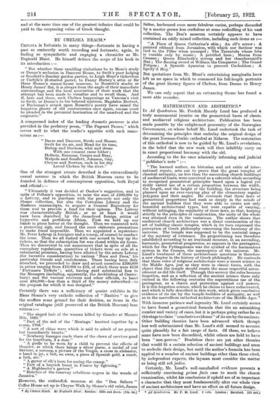ARISTOTLE AND TIlh ARABS.* MOST people connect the revival of
Greek studies in Western Europe with the fall of Constantinople in 1453, when the Byzantine scholars who were fortunate enough to escape massacre fled to Italy, bearing with them manuscripts of the Greek classics. This popular theory, though in part true, overlooks the fact that there had been a great revival of Hellenic philosophy three centuries earlier, and that it was caused by the trans- lation into Latin of Arabic versions of and commentaries on the works of Aristotle, Which until then had been known only by imperfect summaries such as that of Boethius. This renewed contact between mediaeval Europe and ancient Greece was effected, strangely enough, at Toledo, where the scholarly Archbishop Raymond set up a college of translators to make the learning of the Arabs accessible to Christians. How was it that Aristotle and Plato, long forgotten in the troubled West, had survived as active and potent influences in the East T Hbw • Arabic Thought and Sc Place in History. By Dr. De Lacy O'Leary, London: Ream Paul_ Rea. ea. nct.e was It that Dante, enumerating the famous philosophers wham he met in the Inferno, coukl, include two Moslema,—Ibn
or Avicenna, of Bokhara, and Ihn Rushd,-or Averroes, of Cor- dova—in the list ?
" Socrate e Platen° . . Euclid° geornetm . . .
Ippocrate, Avicenna e Galieno, Averrois chel gran corneal° feo."
The answer will be found in a most interesting book just written by Dr. O'Leary, of the University of Bristol, on the transmission of Greek thought to the Islamic world and its retransmission to the Christian West; Dr. O'Leary's book might be improved by a_ careful revision and by the addition of an index, but his account of the strange experiences of the Aristotelian philosophy in the East while Europe was painfully struggling through the Dark Ages of barbarism and reconstruction is well worth reading.
The earliest missionaries of Hellenism to the East, in the post-classical age, were the Syrian heretics known as Nestorians. Cast out by the Orthodox Church, they found a refuge under Persian rule first at Nisibis—halfway between the Euphrates and Mosul—and then at Seleucia, on the Tigris south of Baghdad. The Nestorians and the later heretics known as Monophysitos or Jacobites translated innumerable Greek works, especially Aristotle and Plato and the works of the Alexandrian Neo- Platonists like Plotinus, into Syriac. The Saasanian Kings of Persia were anxious to profit by Greek civilization ; they intro- duced the Greek baths into the East—for the so-called Turkish baths are of Greek origin—and they encouraged Greek architects, artists and scholars. When the Arabs overran. Persia, Syria and Egypt in the seventh century, they had perforce to employ the trained administrators whom they found there, and these officials and other experts were all imbued-with Hellenic ideas. Li the eighth century Arabic, hitherto only the sacred language of Islam, was adopted for the sake of convenience as the adminis- trative language, apparently at the instance of the Christian or Jewish officials. The Greek works that had been-translated into Syriac were now retranslated into Arabic, and Moslem theologians began to adapt the doctrine of the Logos to the Koran. The Caliph Al Mansur, who founded Baghdad' in 765, employed Nestorian physicians, and the later Caliph Al Mainun employed a corps of translators to make the wisdom of Greece accessible to the faithful. Dr. O'Leary warns us not to regard the spread of the Arabic language as equivalent to the spread of Arabic culture—for that culture was mainly Greek and partly Pensian or Indian and owed little or nothing to the Arabs themseltee. His account of the way in which Aristotle and Plato influenced the development of Moslem theology and of the innumerable Moslem heresies is curiously interesting. The leaders of the Shins, whose stronghold has always been- in Persia, the land of free thought, showed a special interest in Neo-Platonism. One offshoot of Persian modifications of Islam was the curious sect of Nizarisar Assassins, controlled by the- Sheikh of Alamut whom the Crusaders called the "Old Men of the Mountain." The Agha Khan is a lineal descendant of the last Sheikh, whom the Mongols overthrew in. the thirteenth century, and he still has many followers.
In the later years of the tenth century there began a strong orthodox reaction in Asiatic Islam, and the Moslem students of Greek philosophy began to regard Spain as a place of refuge. The Jews, too, who had been accustomed to look to Mesopotamia as the chief seat of Rabbinical studies, set up an academy in Cordova. Thus Moorish Spain became the centre of learning in Islam.. The Sultans of Granada were on the whole tolerant to scholars, provided always that they confined their heretical speculations to learned treatises. Ibn Rushd, or Averroes, was a court physician ; he was banished as a heretic for a time— perhaps, as Dr. O'Leary suggests, because his master was on the eve of a religious war and desired to prove his own orthodoxy —but when the war was over and the Emir had returned to Morocco, Ibn Rushd reappeared- in his train; Jewish refugees from Spain introduced Averroes to the learned men of Provence atul to ?the court of Frederick IL in Naples and Sicily. Averroes' chief follower was the Jew, Ibn Maymun, whom the West knew as Maimonides. He wrote in Arabic but his works were trans- lated into Hebrew and had a great vogue in mediaeval Jewry. Averroes' writings were also put into Hebrew and retranslated into Latin. Thus by a long and roundabout process Aristotle was restored to Western Europeand; largely thronghthe influence of the Friars in the thirteenth century, became the basis of philosophic studies at the universities. It is a curious story
and at the same time one of the greatest tributes that could be paid to the surpassing value of Greek thought.



































 Previous page
Previous page